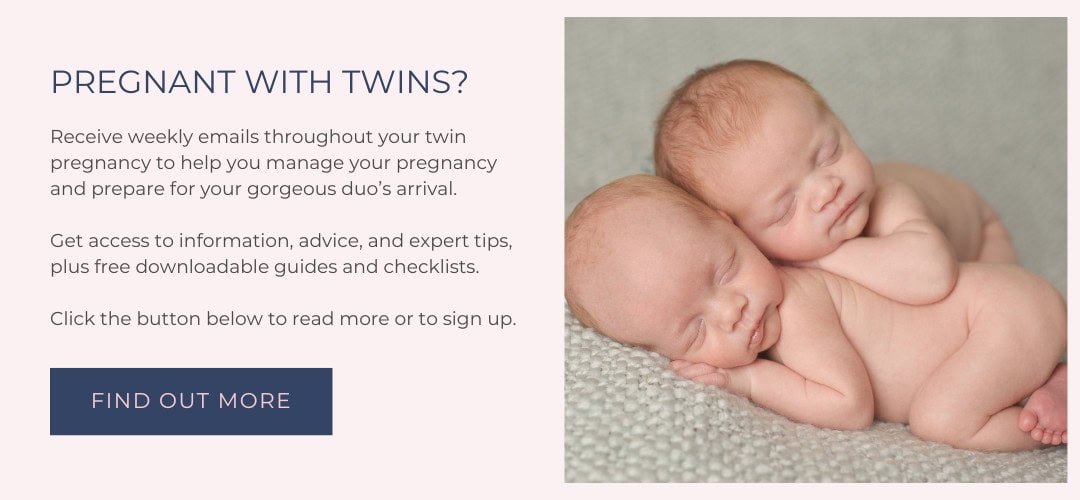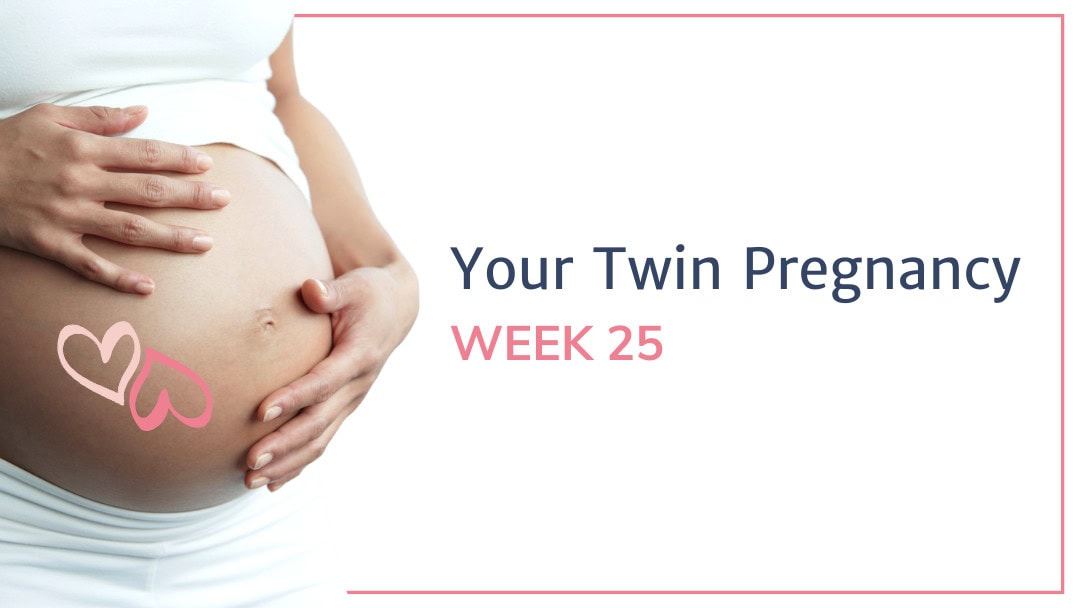Welcome to Week 25 of your twin pregnancy, mama! Can you believe you’re already at the 25-week mark?
By now, you’re probably getting more and more excited about meeting your little ones and perhaps also a bit anxious about their arrival. This week, we’re going to focus on one important part of preparing for their arrival: Your Twin Birth Plan.
Having a birth plan for your twins can help you feel empowered and prepared for the big day. But remember, while it’s important to plan and share your ideal birth experience with your pregnancy care team, flexibility is key—especially with twins.
Let’s talk through everything you need to consider as you start thinking about what you’d like your birthing experience to look like.

How are you feeling mama?
Twin Pregnancy Symptoms at 25 Weeks
As you reach 25 weeks in your twin pregnancy, your body is continuing to adjust to carrying two growing babies, and you’re probably noticing some new or intensified symptoms. Here’s a rundown of common twin pregnancy symptoms you might be experiencing this week and some tips on how to manage them:
Shortness of Breath
With your babies growing bigger, your uterus is pushing up against your diaphragm, making it harder for your lungs to fully expand. This can cause that feeling of being out of breath, especially when walking up stairs or doing everyday tasks.
I vividly remember presenting at a large client meeting at around 25 weeks and feeling like I had two pairs of feet tap dancing on my lungs making it very hard to breathe – it was not pleasant, and terrible timing.
How to manage it:
- Take frequent breaks when moving around or standing for long periods.
- Practice slow, deep breathing exercises.
- Sit upright to improve airflow and use pillows to prop yourself up while sleeping.
Heartburn and Indigestion
Your expanding uterus is also pressing on your stomach, which can cause acid reflux or heartburn, especially after meals. With twin pregnancies, these digestive issues tend to intensify as the babies take up more space.
How to manage it:
- Eat smaller, more frequent meals instead of three large ones.
- Avoid spicy, fatty, or acidic foods that can trigger heartburn.
- Try sleeping with your head elevated to reduce acid reflux at night.
- Having something like quick-eze handy also can help
Swollen Feet and Ankles (Edema)
Swelling, especially in your feet, ankles, and legs, is common at this stage because your body is retaining more fluids and your blood circulation is being impacted by the extra pressure from your babies.
How to manage it:
- Elevate your feet whenever you’re sitting or resting.
- Wear comfortable, supportive shoes and consider compression socks to reduce swelling.
- Stay hydrated and avoid standing for long periods.
Back Pain and Pelvic Pressure
As your belly grows heavier, you might feel more strain on your lower back and pelvis. The extra weight of two babies can cause your center of gravity to shift, leading to discomfort or pain in your back and hips.
How to manage it:
- Practice good posture by standing up straight and avoiding slouching.
- Use a maternity support belt to help distribute the weight of your belly.
- Gentle prenatal yoga or stretches specifically designed for the back and pelvis can offer some relief.
Braxton Hicks Contractions
These “practice contractions” may become more frequent as your uterus prepares for labor. With twins, it’s common to feel Braxton Hicks earlier and more intensely, but they are usually irregular and shouldn’t be painful.
How to manage it:
- Stay hydrated, as dehydration can trigger Braxton Hicks contractions.
- Rest when they occur and change positions to see if they subside.
- Keep track of the frequency and intensity of contractions—if they become regular or painful, contact your healthcare provider.
Increased Fatigue
Carrying two babies is a lot of work! Fatigue can hit hard during a twin pregnancy, especially as you near the third trimester. Your body is working overtime to nourish two growing babies, leaving you feeling drained at times.
How to manage it:
- Rest as much as possible—take naps when you can and prioritize sleep at night.
- Listen to your body, and don’t push yourself too hard. It’s okay to slow down.
- Eat nutrient-rich foods to keep your energy levels stable, and make sure you’re getting enough iron and protein in your diet.
Frequent Urination
As your babies grow, they’re putting more pressure on your bladder, which means more trips to the bathroom, especially at night. This symptom is typical as you approach the third trimester.
How to manage it:
- Try to empty your bladder completely each time you go to the bathroom.
- Avoid drinking large amounts of fluids right before bed to reduce nighttime bathroom trips.
- Do pelvic floor exercises (like Kegels) to help strengthen the muscles around your bladder.
What are your twins up to this week?
Your Twins at 25 Weeks – Height & Weight
Your babies are each about the size of a rutabaga or turnip this week! They likely measure around 13.5 inches (34 cm) long and weigh close to 1.5 pounds each (that’s about 680 grams).
While their growth continues at a similar pace, keep in mind that fraternal twins may grow at different rates, with one baby potentially being a bit bigger than the other. Identical twins are often closer in size, but differences in growth can still happen and will be monitored closely by your pregnancy care team.
Your Twins’ Fetal Development at 25 Weeks
At 25 weeks, your twins are experiencing rapid growth and development as they prepare for life outside the womb. Here’s a snapshot of what’s happening with your little ones this week:
Their lungs are producing surfactant, a vital substance that will help them breathe by keeping the tiny air sacs open after birth. While they’re practicing breathing motions, they still need more time to mature and may need assistance if born prematurely.
Their skin, once thin and translucent, is now becoming more opaque as they continue to accumulate fat. This fat will help regulate their body temperature after birth, giving them a more filled-out, smooth appearance.
Though their eyelids remain closed, their eyes are fully formed and preparing to open in the coming weeks. Their hearing is well-developed, and they can now respond to external sounds, including your voice and music, making this a perfect time to talk or sing to them!
Your babies’ brains are undergoing a growth spurt, developing more neural connections and refining their sleep-wake cycles. Their brain activity is becoming more complex, laying the groundwork for future learning and memory.
Your twins are continuing to practice swallowing amniotic fluid, which helps develop their digestive systems. They can also taste flavors from the foods you eat, which change the taste of the amniotic fluid.
Your babies’ immune systems are beginning to develop, though they’ll still rely on antibodies from you, especially through the placenta and breast milk, to protect them after birth.

What You Might Be Wondering About This Week
Your Twin Birth Plan
As you reach 25 weeks, it’s a great time to start thinking about the birth of your twins and what you’d like your experience to be. While having a plan is important, twin pregnancies come with extra considerations, so flexibility is key. Let’s dive into some of the common topics you might be thinking about this week as you prepare your birth plan.
Vaginal Birth vs. C-Section: What to Expect for Twins
A major decision many twin moms face is whether to plan for a vaginal birth or a C-section. With twins, this choice often depends on the position of the babies. If both twins are head-down (vertex position), a vaginal birth may be recommended. However, if one or both babies are breech (feet or bottom down) or in an unusual position (such as transverse or sideways), your doctor might recommend a planned C-section for safety.
It’s also possible for one baby to be born vaginally (Baby A), while Baby B may require a different approach, such as a breech extraction or even a C-section if complications arise.
It’s important to talk to your Doctor or OB/GYN about both options and remain open to adjusting your birth plan as you get closer to your due date.
The Importance of Flexibility in Your Twin Birth Plan
With twin pregnancies, flexibility is crucial. Births don’t always go according to plan, and with twins, there’s a higher likelihood that medical decisions may need to be made in the moment. For example, you may plan for a vaginal delivery, but if one or both babies show signs of distress, a C-section may become necessary.
Your birth plan can still outline your preferences—such as whether you’d like to avoid certain interventions, your pain management preferences, or immediate skin-to-skin time—but understanding that things can change will help you feel more prepared for different outcomes.
Thinking of your birth plan as a guide rather than a strict set of rules can help avoid disappointment if things don’t go as planned on the day.
Choosing Your Birth Environment: Hospital, Birthing Center, or Home
While some moms with singleton pregnancies may opt for a birthing center or even a home birth, for twin pregnancies, most healthcare providers strongly recommend giving birth in a hospital. This is because twin births carry a higher risk of complications, such as preterm labor, the need for a C-section, or issues with one or both babies needing immediate care after birth.
A hospital provides access to specialized equipment and a neonatal intensive care unit (NICU), which may be needed if your twins are born early or need extra support after birth.
If you’re hoping for a more natural birthing environment, talk to your provider about creating a calm, supportive atmosphere in the hospital to combine the best of both worlds.
Understanding the Roles of Your Twin Birth Team
With twins, the size of your birth team is often larger than with a singleton pregnancy. Aside from your primary OB-GYN, you may also have a maternal-fetal medicine specialist involved in your care, especially if you’re carrying identical twins or have a high-risk pregnancy. An anesthesiologist will likely be on standby if an epidural or emergency C-section is needed.
Additionally, a team of neonatal specialists or NICU staff may be present at the birth to check your babies immediately after delivery, particularly if they’re premature. Understanding who will be involved and their roles can help you feel more confident about the extra care and attention your babies will receive.
Things can move fast on delivery day, and having a room full of medical specialists can be overwhelming. Knowing why they are all there and the important roles they play in keeping you and your babies safe and healthy can help minimize the overwhelm.
Monitoring During Labor with Twins: What to Expect
Labor with twins usually involves more monitoring than with a single baby. Expect to have continuous fetal monitoring to track both babies’ heart rates throughout labor, as your care team will want to ensure that both babies are doing well. This might involve wearing two monitors on your belly or occasionally checking their positions with an ultrasound.
Additionally, an IV line may be placed early on, even if you don’t need immediate medication. This is done as a precaution in case you need fluids, antibiotics, or quick access for any other medications during labor. While this extra monitoring can sometimes feel restrictive, it’s all in the interest of ensuring your babies’ safety.
Deciding on Pain Relief Options: Epidurals and Beyond
Pain relief options are an important part of any birth plan, and with twins, many providers will recommend an epidural. While it’s not mandatory, having an epidural in place during twin labor can be helpful if complications arise, such as needing to manually reposition Baby B or perform an emergency C-section after Baby A is born.
That said, if you’re considering other forms of pain relief, such as nitrous oxide (laughing gas), IV medications, or more natural pain management techniques, discuss your options with your care provider. You may still have choices even in a twin birth scenario, and knowing what’s available can help you feel in control.
Birth Preferences for Baby B: What Happens if One Twin is Breech?
In some cases, Baby A may be born vaginally, but Baby B could present differently. After Baby A is delivered, the doctor will check the position of Baby B via ultrasound. If Baby B is breech or transverse, your doctor might attempt to manually turn the baby into the head-down position, or they may perform a breech extraction, which involves delivering Baby B feet-first if it’s safe to do so.
In some cases, Baby B may need to be delivered via C-section, even if Baby A was born vaginally. Discussing these possibilities with your doctor is a good idea so you’re mentally and emotionally prepared for different outcomes.
Postpartum Recovery After Twin Delivery: Vaginal vs. C-Section
Recovery after delivering twins varies depending on whether you have a vaginal birth or a C-section. With a vaginal delivery, your recovery might be quicker, though the physical demands of delivering two babies can still lead to more soreness or exhaustion. You’ll also be dealing with the postpartum bleeding (lochia) and healing of your perineum, especially if you had any tearing or needed stitches.
If you have a C-section, your recovery will be longer, as it involves healing from abdominal surgery. You’ll likely need help with everyday tasks like lifting the babies, getting in and out of bed, and caring for yourself while managing two newborns. You will also need to care for your C-section wound.
I was really worried about having a C-section as I knew that I had to look after my girls on my own once they were born. I ended up having a C-section as my planned natural birth just wouldn’t progress, so the Doctors decided that my babies needed to come out close to 24 hours after my induction. I really had nothing to worry about as I had minimal pain, and there was very little that I couldn’t do (as long as I took it easy). Other than a wound that was a little slow to heal and required a bit of extra care, it all went well.
Be sure to prepare for both physical and emotional recovery, regardless of your delivery method, and don’t hesitate to ask for help!
Planning for NICU Time: What to Know in Advance
Many twin pregnancies result in preterm birth, which means that your babies may need time in the NICU (Neonatal Intensive Care Unit). While it’s not a certainty, it’s good to prepare for this possibility. NICU stays can vary from just a few days to several weeks, depending on your babies’ health and development.
The NICU staff will monitor your babies for things like breathing issues, feeding problems, and body temperature regulation and may assist with getting them on a feeding schedule (a huge bonus).
You’ll still be able to bond with your babies, hold them, and start breastfeeding if they’re ready, even while they receive extra care.
Before you go…
Clear communication is key when creating a twin birth plan. Make sure to discuss your birth preferences with your partner, medical team, and any support people who will be with you during delivery.
Write down your key wishes and ensure your doctor understands your priorities—whether that’s your stance on pain management, preferences for immediate skin-to-skin contact, timing of the cord cutting, or your hopes for a vaginal birth.
While staying flexible is important, feeling confident that your wishes are known and respected will help reduce stress and make the birth experience as positive as possible.
Don’t hesitate to advocate for yourself, but also remember that your medical team is there to support you and will guide you toward what’s safest for both you and your babies.
Take care and much love.

P.S. Want to receive a reminder email to come back and read the next post in this Twin Pregnancy series? Register for our Twin Pregnancy & Preparing for Twins emails, and it will drop straight into your inbox.


